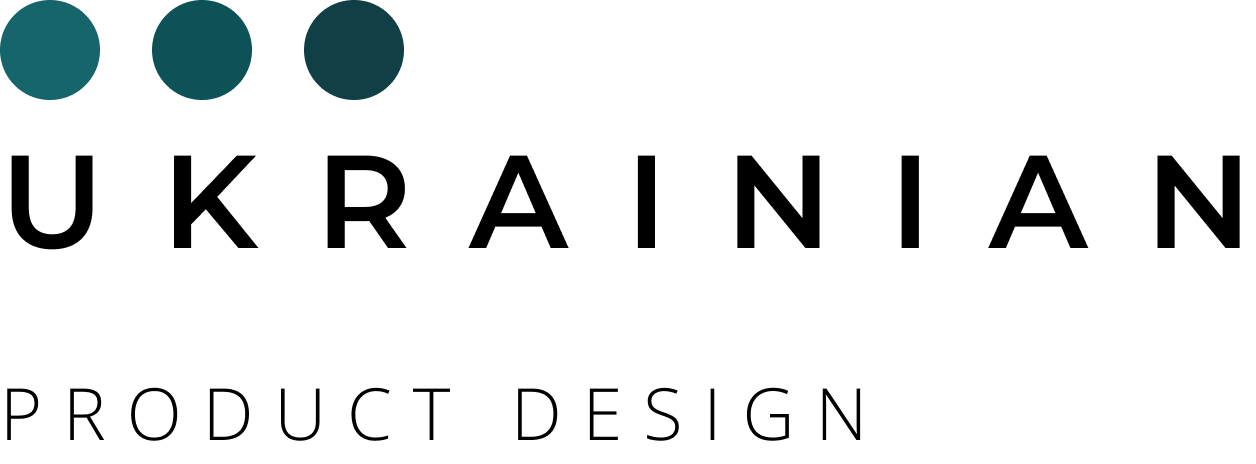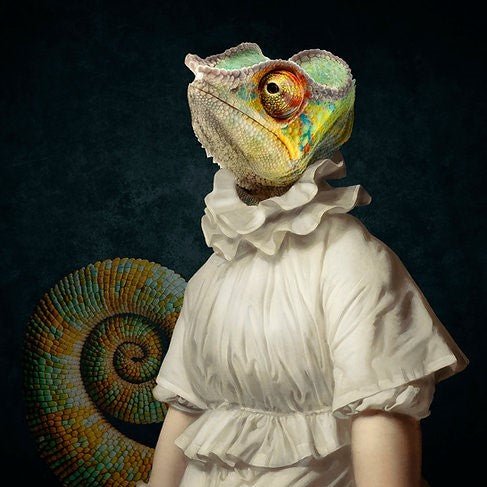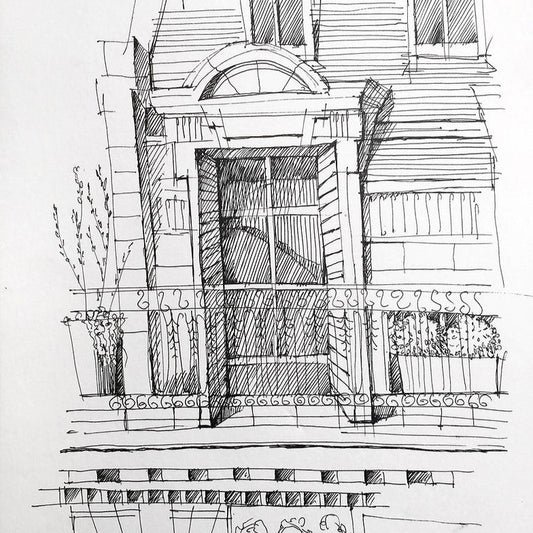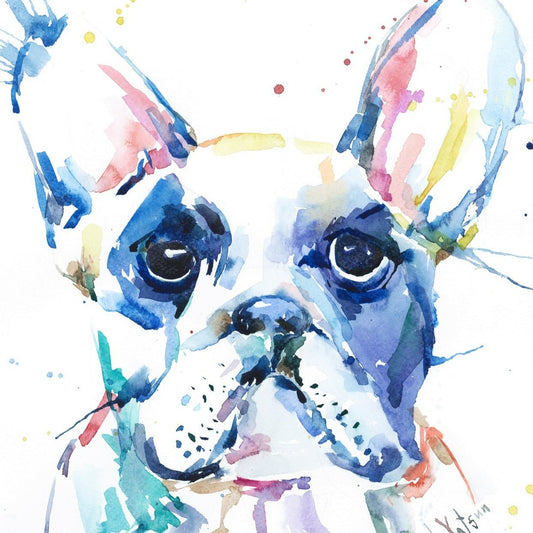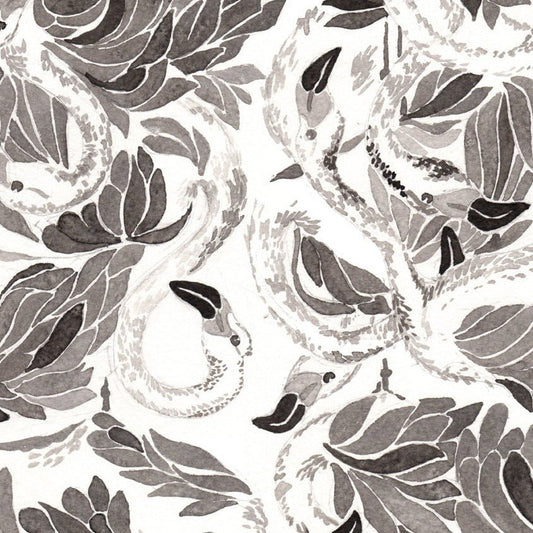THE ARCHITECTURE THAT INSPIRED THE O COLLECTION – WALLPAPER DESIGNED IN COLLABORATION WITH ELLE DÉCOR UKRAINE
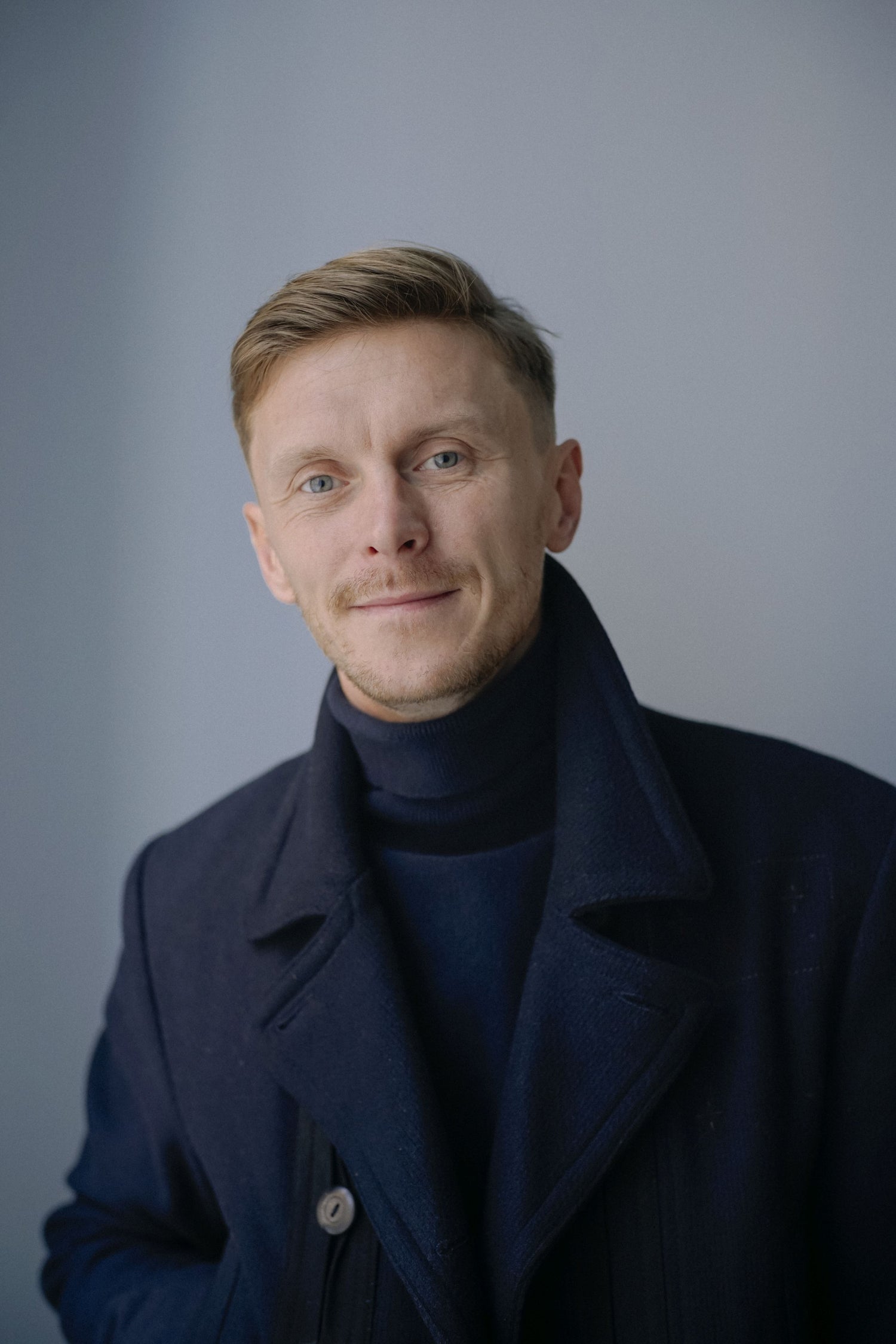
Designed by Yevhen Lytvynenko in collaboration with Elle Decoration Ukraine, the O collection of wallpapers was inspired by the architectural beauty and familiar landmarks of Kyiv creating a profound connection with the city. Celebrating modern constructivism, which originated in the 1920’s, they are an assortment of abstract compositions.
Skillfully arranged using augmented reality technology, the designs feature layers of geometric shapes and fragmented vintage photographs interspersed with tapestries of flora and fauna. The compositions capture a snapshot of life experiences, places and people and reflect deep heartfelt sentiment.
Inspired by Bauhaus style which originated in Germany in early 20th Century, Yevhen created artistic collages to add depth and interest. To prevent them overwhelming the space, he used a background of muted colourways and subtle architectural silhouettes, that blend seamlessly with other interior elements. The effect provides a fascinating, textural and symbolic story that alludes to the beating heart of the city gently calling its name without jarring the senses.
But what do we know of the landmarks that inspired the designs?
-

Nikolai Grishko National Botanical Garden
-

Trukhanov Island. Willows
-

Botanical Garden named after academician Alexander Fomin
The Kyiv-Pechersk Lavra
-
The Kyiv-Perchersk Lavra or Monastery of the Caves, by which it is also known, is a hugely symbolic building in Kyiv and the most sacred religious site in Ukraine. Now owned by the Ukrainian government, it originated as a working monastery and some of the buildings are still used for that purpose today. Founded in the mid-11th Century by Saint Anthony, the site provided an idyllic retreat to practice religion, cocooned in the peaceful womb of its underground caves lying deep beneath the foundations. Overlooking the Dnieper River, on the side of Mount Berestov, some distance from the City Centre, it has gained reverence and significance over the years. Some buildings were converted into a museum in 1926 when it became a centre of cultural and historical importance displaying religious artefacts.
-
Over the years the monastery added many more items to its collection including early manuscripts and handicrafts from local artisans alongside press and print-making work from its own well-known printing house. The collections attract hordes of visitors each year. Pilgrims make the journey to visit the holy site and explore the complex caves which now house the catacombs, the ancient tombs of the mummified early monks alongside their founder. In 1990, UNESCO declared it a World Heritage Site.
-
-
Sadly, the passage of time, political unrest and war have not been kind to the monastery, and it has suffered devastating consequences. Its cathedral was destroyed during World War 2 and many objects were removed from the museum, put into storage, or transferred to other countries. As a result, the collections are diminishing. Today the current invasion of Ukraine again poses a threat to the monastery. With so many religious churches and institutions destroyed in the current war, it is not hard to see why Yevheni chose to immortalise the site, rich with cultural, historical and spiritual heritage.
-
To capture the essence of the landmark in an artistic snapshot, he focuses on the frescoes which adorn the walls. With its layers of architectural arches framing muted palettes of rolling hills and trees, it takes on the appearance of a softly painted watercolour. Augmented reality depicts a hidden layer showing hands passing you a heart which poetically symbolises shared love. Contrasted with sharp geometric lines, the design creates an elegant, intriguing yet calming backdrop to a living space rich with history. To keep it practical, the paper has non-woven vinyl coating, making it extra durable and easy to wipe clean to preserve its natural beauty.
The House of Actors
-
‘A little further from the famous Golden Gate, we will find a charming exotic place’….
-
Another notable building in Kyiv, chosen for the O Collection, stands out due to its unusual and highly decorative façade. The House of Actors has architectural detailing unlike anything else found in the city, with Moorish-Arabic influence which is the work of Milan born Emilio Sala. Ornate stucco decorations rise like majestic stalactites from the exterior giving the building its unique character which has been cleverly captured using layers of augmented reality. The layers include tattered photos hanging on the windows in the adjacent abandoned house depicting romantic kisses which evoke nostalgic romance together with classic architecture. Visible from the window of Yevhen’s studio, he was inspired to capture its charm after catching sight of it one evening whilst working.
-
The name came about when the building was occupied by the National Union of Theatre Workers in 1981. Completed in 1902, it was originally used as a Kenesa (place of worship and prayer) for the Karaites in Eastern Europe who travelled from Crimea. The culture was largely dispersed during Soviet times when religious expression was banned, hence why the design is unique to the city. Strongly associated with the tobacco industry, around 650 wealthy Karaites moved to Ukraine at the turn of the century. Keen to make their mark on the city, they used their considerable wealth to commission the very best of designers which included Jewish designer Lev Ginsburg, renowned for many beautiful buildings in Kyiv in the 1890s and Polish architect Vladislav Gorodetsky, a well-respected figure in Kyiv who also created the National Opera House and House of Chimeras in Kyiv.
-
Over the years, the building has seen many uses. After 1926 it became a political education institution, later a puppet theatre and in 1952 a cinema. Now the building is an intimate concert hall with seating for 200 with its amazing acoustics, impressive entrance hall and theatrical library. Here, during peaceful times, the community of Kyiv can enjoy theatrical performances, concerts, creative evenings, conferences, and art exhibitions.
Reference: Mykhailo Kalnytsky, historian
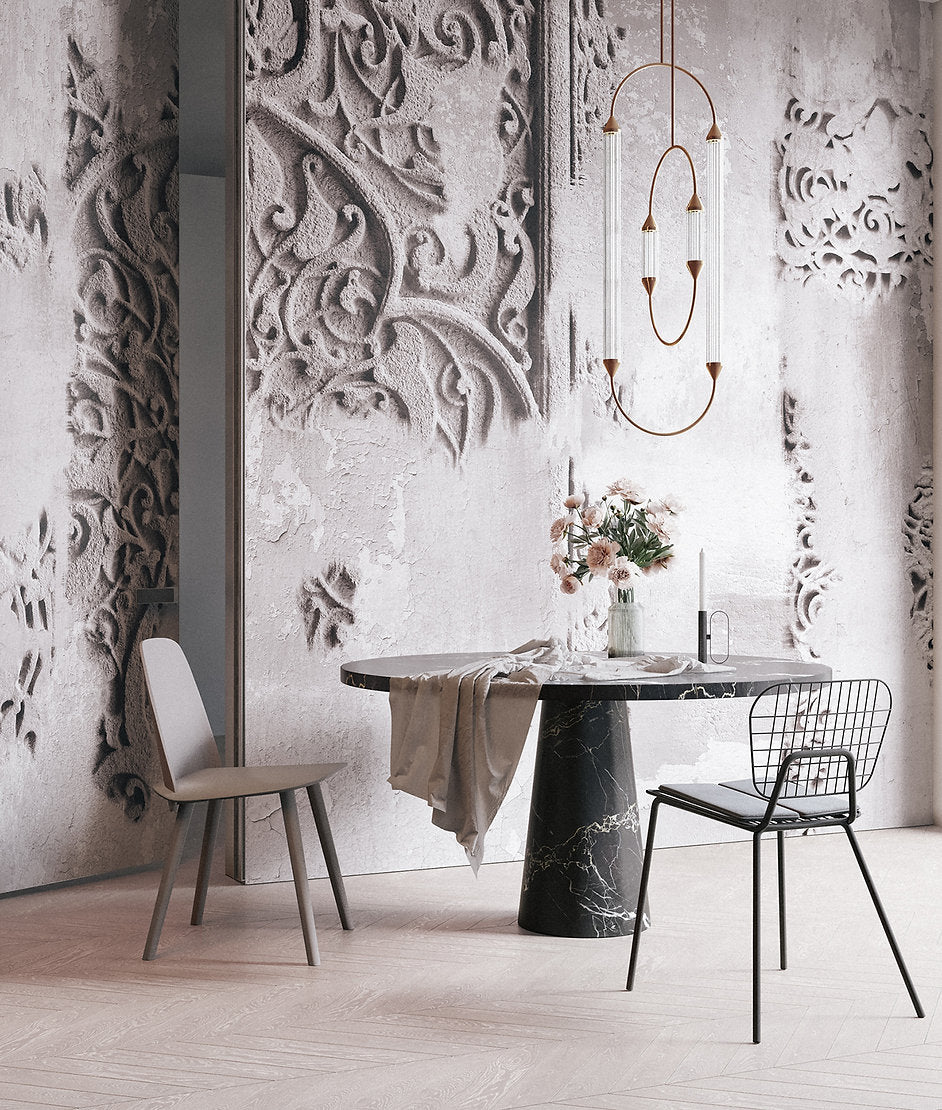
The exterior facade shows outward signs of erosion due to atmospheric gases and repeated painting which has caused it to dull and lose its once bright exterior. Ornate friezes are skillfully depicted in palettes of grey, black and ivory creating shadows and depth that create an authentic patina. Detailed embellishments contrast with the powerful presence of earthy erosion. This delicate crumbling design, preserved in digital form, invites you to touch it to trace its intricate patterns and stumble upon the naturally worn bumps and hollows. Adding a delightfully tactile and understated elegance to any stylish home, it is available in custom dimensions to suit every space.
The Mosaic of the Pecherskaya Metro Station
-
Fast forward from the turn of the century to the 1960’s Soviet era, to discover the unexpectedly beautiful interior of the metro underground with its opulent chandeliers, marble facades, painted mural ceilings and decorative mosaic artwork. It is the latter that Yevhen chosen to incorporate in the aptly named ‘Mosaic of the Pecherskaya Metro Station’ situated on the Boulevard of Lesya Ukrainka. The rise in decadent art for urban transport came about originally to spread communist idealism but some were rejected in favour of work by Ukrainian poets and authors and filmmakers. The Pecherskya Metro station mosaic was designed by recently departed Anatoly Haydamaka, People’s Artist of Ukraine, and Larisa Mishchenko, another renowned monumental artist. They include several images of a shepherd and his sheep, the grape harvest, a peacock, a forest shaft, Polonina (meadow topped mountains), The Cosmos and The Underwater World. Following the collapse of Soviet rule in the early 1990’s, many mosaics were neglected or destroyed. There is a movement that calls for their restoration since they represent an important part of Ukrainian art history.
-
-
Yevhen seeks to preserve them in his own creative way. His design prints include soft mosaic tiles displayed in large-scale abstract form, framed within oblong shapes whose curves reflect those found in the metro system. Through the augmented layers you can catch a glimpse of a naked female form female form fashioned from mosaics whose head is artfully disguised with abstract oblong shapes. Prints are available in muted greys and rose vintage hues to blend harmoniously with existing décor and can be customised to scale.
-
-
Within the O collection you can find further iconic landmarks such as ‘The Artists House’ reflecting subtle compositions of art, craft and culture through a curtain of silver and gold, ‘Zhytniy Market in Podol’ , the oldest shopping centre in Kyiv captured by its prominent geometric patterned roof tiles and the controversial yet historical ‘People’s Friendship Arch’. Each landmark tells a story, steeped in history, politics and art and each holds hidden layers that add interest and intrigue as they unfold in different light. It’s a fascinating representation of symbolic architecture with abstract art that keeps surprising you. Every print is created individually for custom order.
-
-

Artist's House
-

Zhytniy Market in Podol
-

People's Friendship Arch
-
Giving thought to practicality, the paper is durable, easy to install and can be wiped clean once dry. It is made with a no-burn fireproof material that has been certified for safe use.
-
-

Kyiv at Night
-

The Hotel "Salute"
-

"Flying saucer" at Lybedskaya metro station
-
As Kyiv continues to come under fire from missiles, the desire to preserve, treasure and retain these landmarks is even greater. Here is just a taste of what you can expect. You can explore more designs from the O collection here.
-
-
The USAID Competitive Economy Program in Ukraine (USAID CEP) supports startups, small and medium enterprises (SMEs) aiming to provide support for competitive industries and firms on Ukrainian and international markets, foster a better business-enabling environment and enable Ukrainian companies to benefit from international trade.
The items used in the project
-
Wallpapers Chameleon
Regular price £67.00 GBP per 1 sq. meterRegular priceUnit price per -
Wallpapers View from the window Paris
Regular price £67.00 GBP per 1 sq. meterRegular priceUnit price per -
Wallpapers Dog Archibald
Regular price £67.00 GBP per 1 sq. meterRegular priceUnit price per -
Wallpapers Flamingo
Regular price £67.00 GBP per 1 sq. meterRegular priceUnit price per
